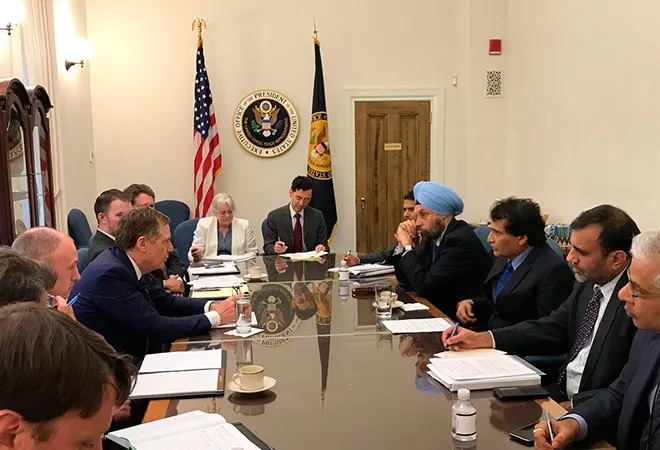
At the recent G7 summit early this month, President Donald Trump simply walked out of the meeting saying that he won’t allow ‘Fool Trade’. He rudely torpedoed what seemed a fragile consensus by saying “Sorry, we cannot let our friends or enemies take advantage of us in trade anymore. We must put the American worker first.”
The US President has a point. Over the last few decades, America has imported twice as much it has exported. Despite its technology advantage the US trade deficit is around $817 billion if products are considered and $ 568 billion if products and services are considered. The only two sectors that America exports more than its imports is the services industry and the agriculture and livestock industry. America has a trade deficit with every nation of the G7 and that deficit has been increasing each year. Even with India, the US has trade deficit of $21.3 billion. President Trump wants to correct that. Trump wants to correct all trade imbalances with tariffs that will force other nations to cut back on exports or lower their own domestic tarrifs and allow American exports.
In India’s case, Trump wants duty reduction in Harley Davidson bikes, stents, knee implants and medical devices and dairy and poultry products among others. India has already reduced duty on high powered bikes to 50% from 75%, but Trump remains unimpressed. Commerce Minister Suresh Prabhu is looking at the other points on the list and visited the US to sort out the issues bilaterally. Prabhu rightly says that imports of commercial aircraft and natural gas from the US can correct the trade imbalance. India needs natural gas to reduce atmospheric pollution as its own domestic production is falling.
But apart from rectifying the trade imbalance with the US which is a defensive step, India needs to move aggressively to correct its trade imbalance. When old trade agreements break down or become uncompetitive due to any reason, new suppliers get the opportunity to fill the gap.
India needs a new export import strategy
With the rise in crude prices, India needs to rework its import and export strategy. Even though the crude prices are below $80 a barrel the CAD has ballooned to1.9% of the GDP. Oil imports resulted in a net outflow of $72 billion in FY 18 and could easily exceed $100 billion during the current year. The trade deficit showed a 42% jump to $160 billion during the year 2017-18 and could go higher next year unless a new strategy is chalked out.
India needs to appoint an industry observer group that shortlists importers of goods worldwide affected by US tariff war and retaliatory action -- an expert group that advises our exporters on new opportunities. Trump’s decision and tariff raising policy will create huge trading opportunities around the globe which Indian companies could pick up if they are aware and nifty.
But first let us explore which are the areas that will be the most affected and the most vulnerable. Also China its largest trading partner has already started retaliating. So the first inflection point should be where the conflict is most apparent and far reaching.
Agricultural produce shows new demand centres
America is the largest exporter of agriculture products worldwide and its farm exports help the American farmer stay prosperous and happy.
Farmers are the core constituency of President Donald Trump. Agriculture exports can pick up for India due to the US initiated trade war.
China has already levied retaliatory tarrif on 90 farm and livestock products from the US including fruits like apple and guava and livestock like fish and pork. But the Chinese demand has not decreased so it has started sourcing from elsewhere. After the trade war started, China began procuring most of its soy from Brazil instead of the US. It is also looking to substitute several other US farm products because it wants to strike where it hurts most.
In case of India, it has the added advantage, for its farm products are non GM variety. So it will be more accepted both in China and Europe. When it comes to food products the competition is more on the quality and less on the price. Netherlands is one of the largest producers of farm products in the world despite its small area and higher cost of produce. India can push home grown organic farming products in the high end market place that is having a double digit growing.
Software strategy needs to be redrawn
Similarly the software strategy needs to be redrawn as Trump’s dictate changes the hiring pattern of Indian’s in the US. Hundreds of Indians have returned home as TCS, Infosys, Cognizant and Wipro replaced Indians posted in the US with Americans. Contract jobs vanished and large Indian companies started working like American units. This has its advantages because they will have to look for value added jobs to survive. But that increases costs and the smaller US companies started stepping in the vacuum. According to some reports, the smaller US companies have started outsourcing to Indian MSME sector, so Indians have started getting employed again.
Large Indian software companies need to up the ante. Low hanging fruits will disappear with President Trump’s new America first policies. Indian units must get into building operating systems and high end software. Indians are in some of the top position in some of the largest software companies. They have the technology to build it, the trust level to lead teams and the market to buy the services. What they do not have is the capital and entrepreneurship to build really large scalable solutions.
This is where the Chinese can come in. China is the manufacturing centre of the world. It dominates hardware but struggles with software. The reason is its culture of domination. China treats software as a transactional job when it is not. It wants foreign engineers to train the Chinese not work with them to develop solutions. Hence the best software engineers would work for other international firms but not for the Chinese. No wonder China has been unable to develop software like they have developed hardware. So the ZTE’s of the world would always be at the mercy of Google and Qualcomm’s to stay afloat.
This is India’s biggest opportunity to develop high end software within India supported by international funding.
Telecom, banking sector needs consolodition
But for that, the domestic sector must be strong and cash flush. India has been a moderately strong player in the telecom and banking sector software development. But infrastructure development in both sectors has been inadequate due to low capital investment. Both industries are still financially not in the pink of health. Bank NPAs are yet to peak and resolutions have just started. It will take at least another year to see some stability. Similar is the case of the telecom sector. Three or four companies in the fray. They are one too many unless each has a deep pocketed overseas funding partner. More mergers and acquisitions must take place to have strong balance sheets. Only then infrastructure will get the real push.
Due to poor infrastructure quality of telecom and banking services are not world class. Call drops still plague the nation and internet connectivity is not high quality on a consistent basis. Similar with banking. Services, both in private as well as public sector banks, is still not world class. It is now or never. If the push for digital India forces telecom companies to invest in infrastructure and if the banking sector is revived, then both will be able to invest in high end domestically developed software on a large scale. Only then the top 10 Indian software corporations who mostly work for the overseas companies will invest in India for domestic scalable solutions.
The views expressed above belong to the author(s). ORF research and analyses now available on Telegram! Click here to access our curated content — blogs, longforms and interviews.




 PREV
PREV


